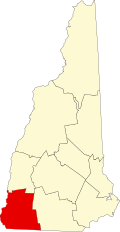Frost Farm | |
 The barn | |
Location in New Hampshire | |
| Location | Korpi Rd., Dublin, New Hampshire |
|---|---|
| Coordinates | 42°52′15″N72°1′35″W / 42.87083°N 72.02639°W |
| Area | 1.3 acres (0.53 ha) |
| Built | 1806 |
| Built by | Benjamin Frost |
| Architectural style | Cape Colonial |
| MPS | Dublin MRA |
| NRHP reference No. | 83004026 [1] |
| Added to NRHP | December 18, 1983 |
The Frost Farm is a historic farmstead on Korpi Road in Dublin, New Hampshire. It includes a farmhouse built in 1806 and subsequently enlarged, and a renovated 19th-century barn. The property is significant for its architecture, and for its ownership by both early settlers and later Finnish immigrants. A portion of the property was listed on the National Register of Historic Places in 1983. [1]


